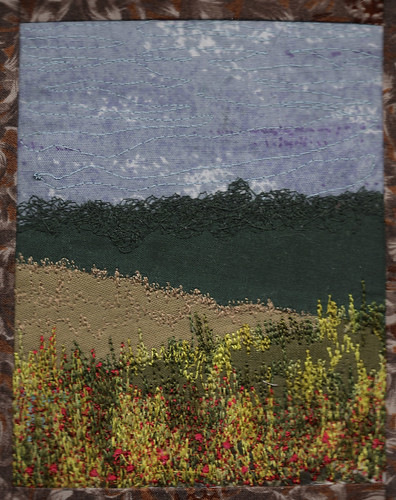I am continuing my link up for free motion stitchers.
A little bit of preliminary. If you want to use your machine for free motion, you need to lower the feed dogs and put a darning foot on. If you are unable to lower your feed dogs, covering them with a bit of masking tape or card will do the job. A great overview of setting up can be found here.
Above all, relax. It is just like scribbling and you will find your skill improves dramatically as you practice. When you learned to write as a child, no one expected you to do calligraphy straight off, so don't expect to make a masterpiece straight away. Just play and practice.
I am going to continue with more straight stitch techniques. I hope to continue this series as we go along.
Obviously, if you are not new to free motion embroidery (FME), then don't worry about the tutorial, just link at the bottom so we can all share what you have done. It doesn't have to be done today or even this week, just post something you have done.
Straight stitches -2
Hopefully, this will be a short blog today as I have videos!
In the videos, there is a short whiteboard session showing how to do each stitch. I'm sure I've said before, that drawing your stitch on scrap paper before you start will always result in a better stitch out. Of course the other thing to remember, is practice.
Last week, we looked at ways to do straight stitch and started to look at the three main straight stitches in thread painting: Granite, Crazy and Weave stitch. Well let's just recap with a picture of granite stitch
Granite stitch is also called encroaching circles and is basically a way to shade, fill and add thread to a piece of thread painting. Granite stitch is also called Garnet stitch in some places. It is very useful for drawing shrubs or treetops in the distance or when done small, gravel on a path or in a creek.
Here is the video, which I didn't have last week
In the videos, there is a short whiteboard session showing how to do each stitch. I'm sure I've said before, that drawing your stitch on scrap paper before you start will always result in a better stitch out. Of course the other thing to remember, is practice.
Last week, we looked at ways to do straight stitch and started to look at the three main straight stitches in thread painting: Granite, Crazy and Weave stitch. Well let's just recap with a picture of granite stitch
Granite stitch is also called encroaching circles and is basically a way to shade, fill and add thread to a piece of thread painting. Granite stitch is also called Garnet stitch in some places. It is very useful for drawing shrubs or treetops in the distance or when done small, gravel on a path or in a creek.
Here is the video, which I didn't have last week
The next stitch, which is really the easiest to do, is multidirectional or crazy stitch.
Crazy stitch is good for backgrounds, particularly places where you don't want the "shine" of embroidery thread, since as the threads are all in different directions, it doesn't reflect light like, say a satin stitch would. This is why it is good for backgrounds, which need to fade into the distance.
Here is the video for crazy stitch.
Weave stitch
Weave stitch is a very useful stitch and looks as it says - wovenWeave stitch needs a picture because it is hard to describe in words, but here goes. Using straight stitch, draw zig zag lines close together in an up and down motion, but of irregular lengths,
Follow this by doing the same in the right/left direction, then begin again in another area, meshing the two together. I think the whiteboard in the video explains it much better.
Weave stitch is particularly good for creating flat surfaces in a thread painting. Man made things like wooden fences and buildings, especially. It is, unlike the other two, a directional stitch, so you need to make sure you orientate it so it makes sense in your picture, ie a fence post does not have diagonal lines.
Here is the video
Next week we will look at some zig zag stitches.




